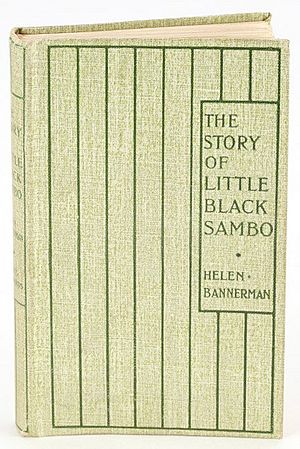The Story of Little Black Sambo facts for kids

1st edition
|
|
| Author | Helen Bannerman |
|---|---|
| Illustrator | Helen Bannerman |
| Country | United Kingdom |
| Language | English |
| Genre | Children's literature |
| Publisher | Grant Richards, London |
|
Publication date
|
1899 |
| Media type | |
The Story of Little Black Sambo is a children's book written and illustrated by Scottish author Helen Bannerman. It was first published in October 1899. This story was very popular for over 50 years.
At first, people thought the book was good because it showed one of the first Black heroes in children's stories. They felt it showed Black characters in a positive way, especially compared to other books at that time. However, in the mid-1900s, some people started to say the book was racist. This was because the names of the characters, like Sambo, were sometimes used as hurtful words for people with dark skin. Also, the pictures were drawn in a style that some found offensive. Because of these concerns, both the words and the pictures in the book have been changed many times since then.
Contents
The Story of Sambo
The story is about a boy named Sambo who lives in South India with his parents, Black Jumbo and Black Mumbo. One day, Sambo goes for a walk and meets four hungry tigers. To stop them from eating him, Sambo gives them his new, colorful clothes, his shoes, and his umbrella.
The tigers are very proud of their new things. Each tiger thinks he looks better than the others. They start a big argument and chase each other around a tree. They spin so fast that they turn into a pool of melted butter, called ghee. Sambo then gets his clothes back and goes home. His father later collects the ghee, and his mother uses it to make many delicious pancakes for the family.
Newer Versions of the Book
Over the years, many people have tried to update The Story of Little Black Sambo. They wanted to make it a story that everyone could enjoy without feeling hurt.
In 1961, a version came out with pictures by Violet LaMont. Her colorful drawings showed an Indian family wearing bright Indian clothes. The story itself stayed the same.
In 1996, a famous artist named Fred Marcellino created a new version called The Story of Little Babaji. He changed the characters' names but kept the original story. Another version from 1996, Sam and the Tigers by Julius Lester, changed the main character's name to "Sam."
A 2003 edition kept the original title but had new pictures by Christopher Bing. These pictures showed Sambo as a happy African child. Some people still felt the title was a problem, even with the new pictures.
In Japan, a version was published in 1997 called Chibikuro Sampo. In this book, the main character is a black Labrador puppy instead of a human boy.
In 2004, a Little Golden Book version was released. It was called The Boy and the Tigers, and the boy's new name was Little Rajani.
Story Adaptations
The story of Little Black Sambo has been made into other things besides books:
- A board game was created in 1924. It followed the story, starting and ending at Sambo's home.
- An animated cartoon of the story was made in 1935.
- In 1939, a record storybook set called "Little Black Sambo's Jungle Band" was released. In this story, Sambo meets jungle animals who play musical instruments, and he becomes their band director.
- In 1961, a dramatized version was released on a record, with Susan Hampshire as Sambo.
Restaurants and the Book's Name
There was a popular restaurant chain in the United States called Sambo's, which started in the 1950s. This chain used characters from the book, like Sambo and the tigers, to help promote their restaurants.
The name "Sambo's" was actually a mix of the founders' names, Sam and Bo. However, because the name was the same as the book's title, it caused problems. People felt that using the name and characters from the book was hurtful due to the book's controversial history. This led to many of the restaurants closing in the early 1980s.
The original Sambo's restaurant in Santa Barbara, California, stayed open for a long time. But in 2020, because of public pressure, its name was officially changed to "Chad's."
Images for kids
See also
 In Spanish: Little Black Sambo para niños
In Spanish: Little Black Sambo para niños



